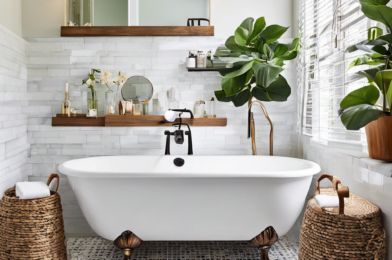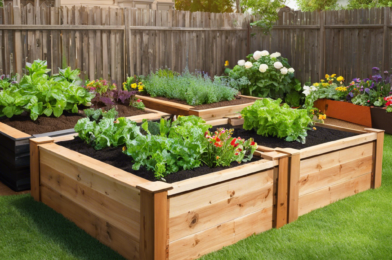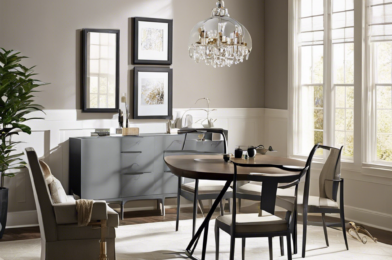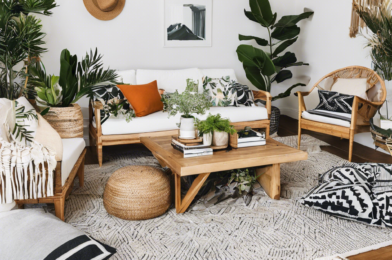Transforming your living space doesn’t always require a major renovation or a hefty budget. With some creativity, effort, and a few weekends, you can significantly enhance your home’s aesthetics and functionality through DIY projects. These projects not only allow you to personalize your space but also provide a sense of accomplishment and can even increase your home’s value. From simple decor updates to more involved improvements, there’s a DIY project for every skill level and style preference. In this guide, we’ll explore 15 weekend DIY projects that can breathe new life into your living space, making it more beautiful, comfortable, and reflective of your personal taste.
1. Create an Accent Wall: One of the quickest ways to transform a room is by creating an accent wall. This project can be completed in a weekend and dramatically changes the feel of a space. You have several options for creating an accent wall: paint it a bold color that complements the rest of the room, apply wallpaper for added texture and pattern, or install wooden planks for a rustic touch. If you’re feeling particularly creative, consider a geometric paint design or a faux brick effect. When choosing your accent wall, opt for the one that naturally draws the eye when you enter the room. This project not only adds visual interest but can also make a small room appear larger or a large room cozier, depending on the colors and patterns you choose.
2. Build Floating Shelves: Floating shelves are a stylish and functional addition to any room, providing extra storage space while serving as a decorative element. This project requires basic carpentry skills but can be completed in a weekend. Start by purchasing wood planks and brackets from your local hardware store. Sand and stain or paint the wood to match your decor. Then, securely attach the brackets to the wall, ensuring they’re level and properly anchored into studs. Finally, attach the wood planks to the brackets. Once installed, you can use these shelves to display books, plants, photographs, or decorative objects. Floating shelves are particularly useful in small spaces where floor space is at a premium, and they can be customized to fit any room’s style, from minimalist to eclectic.
3. Upgrade Cabinet Hardware: A simple yet effective way to refresh your kitchen or bathroom is by upgrading the cabinet hardware. This project requires minimal tools and can be completed in just a few hours. Start by removing the existing knobs or pulls and filling any holes if you’re changing the hardware configuration. Then, choose new hardware that complements your decor style – sleek and modern, vintage-inspired, or something in between. When installing the new hardware, use a template to ensure consistent placement. This small change can have a big impact, giving your cabinets a whole new look without the expense of replacing them entirely. It’s an excellent way to experiment with different styles and can even serve as a starting point for a larger room makeover.
4. Create a Gallery Wall: A gallery wall is a fantastic way to personalize your space and showcase your favorite art, photographs, or mementos. This project allows for endless creativity and can be tailored to fit any style or space. Start by collecting the pieces you want to display – this could include framed prints, photographs, mirrors, or even small sculptural elements. Lay out your arrangement on the floor first to experiment with different compositions. Use kraft paper to create templates of each piece, which you can then tape to the wall to visualize the final layout before making any holes. When you’re satisfied with the arrangement, hang your pieces using appropriate hardware. A gallery wall can transform a bland space into a focal point that tells your personal story and adds visual interest to any room.
5. Paint or Stain Furniture: Breathing new life into old furniture with paint or stain is a rewarding weekend project that can dramatically change the look of a room. Start by thoroughly cleaning the piece and sanding it to create a smooth surface for the new finish. If you’re painting, apply a primer before your chosen color. For a distressed look, sand the edges after painting to reveal some of the original wood. If you’re staining, apply the stain evenly and wipe off excess for a natural look. Finish with a clear protective coat. This project allows you to customize furniture to match your decor perfectly and can save you money compared to buying new pieces. It’s also an excellent way to preserve and update family heirlooms or flea market finds.
6. Install a Backsplash: Adding a backsplash to your kitchen or bathroom can protect your walls from water damage while also serving as a decorative focal point. While traditionally a more involved project, peel-and-stick tile options have made this a feasible weekend DIY. These tiles come in various styles and patterns, from classic subway tiles to intricate mosaics. Start by cleaning the wall surface thoroughly. Measure and cut the tiles as needed, then peel off the backing and stick them to the wall, ensuring they’re level and aligned. Use a grout pen to fill in the gaps for a finished look. If you’re comfortable with more traditional tiling methods, you can use ceramic or glass tiles with mortar and grout. A new backsplash can completely transform the look of your kitchen or bathroom, adding color, texture, and personality to the space.
7. Create a Vertical Garden: Bringing nature indoors not only beautifies your space but also improves air quality and can boost your mood. A vertical garden is an excellent solution for those with limited floor space. Start by choosing a sunny wall or corner. You can create a living wall using a purchased kit or build your own using wooden pallets, picture frames, or even gutters repurposed as planters. Secure your structure to the wall, ensuring it can support the weight of soil and plants. Line the structure with landscape fabric to contain soil and moisture. Choose plants that thrive indoors and have similar care requirements. Succulents, ferns, and trailing plants work well in vertical gardens. Water carefully to avoid oversaturation. This project not only adds a unique design element to your space but also connects you with nature, even in urban environments.
8. Build a Custom Headboard: A custom headboard can serve as a striking focal point in your bedroom and is a project that can be completed in a weekend. There are numerous approaches to this project, depending on your style preferences and skill level. For a simple option, you could upholster a large piece of plywood with foam and fabric, attaching it to the wall or bed frame. For a more rustic look, create a headboard using reclaimed wood planks, either left natural or painted. If you’re feeling ambitious, you could build a tufted headboard, which involves a bit more work but creates a luxurious, high-end look. Whatever style you choose, ensure the headboard is securely attached to prevent accidents. This project allows you to create a one-of-a-kind piece that perfectly complements your bedroom decor and can dramatically change the room’s ambiance.
9. Refresh Your Front Door: Your front door is the first thing visitors see, and refreshing it can significantly boost your home’s curb appeal. Start by cleaning the door thoroughly and removing any hardware. If the door is in good condition, a fresh coat of paint might be all that’s needed. Choose a color that complements your home’s exterior but don’t be afraid to go bold – a bright red or deep blue can make a statement. If the door is wooden and you prefer a natural look, you could strip the old finish and apply a new stain. Consider updating the hardware as well for a complete refresh. You might also add new house numbers or a stylish door knocker. This relatively simple project can have a big impact on your home’s overall appearance and create a welcoming entrance.
10. Create a Reading Nook: Transforming an unused corner into a cozy reading nook is a project that can be completed in a weekend and adds both functionality and charm to your living space. Start by choosing a comfortable chair or small loveseat that fits the space. Add soft lighting with a floor lamp or wall-mounted sconce. Install floating shelves above or beside the seating area to hold books and decorative items. A small side table can provide a spot for drinks or a reading lamp. Complete the nook with a plush rug, soft throw pillows, and a warm blanket. If space allows, you might even build a window seat with storage underneath. This project creates a dedicated space for relaxation and reading, adding value to your home and providing a personal retreat within your living area.
11. Build a Kitchen Island: A kitchen island can add valuable workspace and storage to your kitchen, and building one can be a rewarding weekend project. Start by determining the size and style that fits your kitchen. You can repurpose an old dresser or cabinet as the base, or build one from scratch using plywood and 2x4s. Add casters for mobility if desired. For the countertop, you have several options: butcher block for a warm, natural look; laminate for an affordable and durable surface; or if you’re feeling ambitious, you could even pour a concrete countertop. Add hooks on the sides for hanging utensils or towels, and consider incorporating open shelving or cabinet doors for storage. This project not only increases your kitchen’s functionality but also creates a focal point that can enhance the overall design of the space.
12. Create Custom Closet Organization: Maximizing closet space can dramatically improve your daily routine and the overall organization of your home. This weekend project involves assessing your current closet setup and designing a system that works for your specific needs. Start by removing everything from the closet and taking precise measurements. Consider installing adjustable shelving, hanging rods at different heights, drawer units, and specialized storage solutions like shoe racks or jewelry organizers. You can purchase a closet organization kit or build custom elements using materials from a hardware store. Don’t forget to utilize vertical space with over-the-door organizers or high shelves for less frequently used items. A well-organized closet not only makes your space more functional but can also make your room feel larger and more peaceful.
13. Install Crown Molding: Adding crown molding to a room instantly elevates its appearance, giving it a more polished and elegant look. While this project requires some precision, it’s achievable for DIY enthusiasts with basic carpentry skills. Start by measuring your room carefully and purchasing pre-primed molding. You’ll need a miter saw to make precise angle cuts, especially for corners. Use a stud finder to mark where you can nail the molding securely. Apply construction adhesive to the back of the molding for extra security before nailing it in place. Fill nail holes and caulk gaps for a seamless finish, then paint the molding to match your decor. This project can significantly enhance the visual appeal of any room, adding character and potentially increasing your home’s value.
14. Create a Feature Floor: Transform a room by creating a feature floor using paint or peel-and-stick tiles. For a painted floor, thoroughly clean and sand the existing floor, then apply a primer. Use painter’s tape to create geometric patterns or stencils for more intricate designs. Apply floor paint in your chosen colors, allowing each coat to dry completely. Finish with several coats of clear polyurethane for durability. Alternatively, peel-and-stick floor tiles offer a wide range of patterns and are relatively easy to install. Ensure the existing floor is clean and level before applying the tiles. This project can dramatically change the look of a room, especially in spaces like bathrooms, laundry rooms, or mudrooms where a bold floor can make a big impact.
15. Build a Fire Pit: Creating an outdoor fire pit can transform your backyard into a cozy gathering space. While this project might require a full weekend, the result is well worth the effort. Start by choosing a safe location away from structures and overhanging trees. Mark out the area and excavate to a depth of about 6 inches. Create a level base with gravel. Arrange fire-resistant bricks or stones in a circle, using construction adhesive between layers for stability. Consider adding a metal ring inside for extra protection. Surround the pit with comfortable seating, such as Adirondack chairs or bench seating. This project not only adds functionality to your outdoor space but also creates a focal point for entertaining and relaxation.
These 15 weekend DIY projects offer a range of options for transforming your living space, from simple decor updates to more involved improvements. Each project allows you to put your personal stamp on your home while potentially increasing its value and functionality. Remember to always prioritize safety, use appropriate tools and materials, and don’t hesitate to seek help for tasks beyond your skill level. With creativity, effort, and a little patience, you can significantly enhance your living space, making it more beautiful, comfortable, and reflective of your personal style. Happy DIYing!







